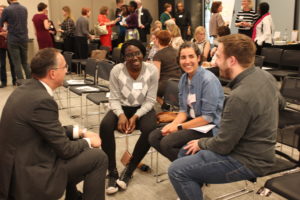Being Heard in a Challenging Exchange
In an Harvard Business Review paper entitled How To Make Sure You’re Heard In a Difficult Conversation, Amy Gallo suggests we focus on what matters to us and express things that way.
It’s easy to point fingers and lay blame at others’ feet. The trouble is, no-one likes to be at the receiving end of criticism, so if they think that you’re criticising them, they won’t be in listening mode. If you can, however, voice what niggles you about the situation, people will be much more inclined to hear and even take responsibility for their action. So, instead of saying ‘Since I’ve been here, you’ve promoted only white men’ try saying ‘I feel like I’m being passed up for promotion for my colleagues who appear to be doing exactly the same as I do’.
As part of any difficult exchange, it’s important to maintain one’s composure and focus on getting to a constructive solution. So, once you’ve identified what you want out of the situation, think about what words will take you off-track and what kind of communication will convey the opposite of what you want to achieve. Is your body language betraying your true feelings about what you hear and hence steering you off course? Is the pitch of your voice giving away heightened emotions that would not be conducive to the desired outcome?
Keeping your eye on the prize makes it easier to ensure you use the right words and gestures. Using phrases that gently swipe away any derailing attempts will make it easier to stay on course. Gallo suggests using phrases like these to avoid escalation:
- “You may be right, but I’d like to understand more.”
- “I have a completely different perspective, but clearly you think this is unfair, so how can we fix this?”
- “I’m not sure how this connects to what we’ve been talking about. Can you help me make the connection?”
- “I’d like to give my reaction to what you’ve said so far, and see what you think.”
- “This may be more my perception than yours, but when you said ‘X,’ I felt . . .”
- “Is there anything I can say or do that might convince you to consider other options here?”
Being Heard in a Meeting
One thing we often do, when it’s our time to present ideas or provide an update, is talk too quickly. We sometimes feel the need to fill every space we get with words. Yet, if you take a look around and observe how people with influence speak, you will probably notice that they speak slowly. And clearly. They pause a lot, giving their audience a chance to catch up with their words.
Speaking without haste doesn’t just give people the chance to properly understand what you’re saying, it also gives the speaker an air of confidence and gravitas. It makes the content of what is being said more persuasive.
We also tend to speed up when we’re nervous, so if we intentionally slow ourselves down, we will come across more confidently – and that will impact how what we say is heard.
Another thing we tend to do, particularly when slightly nervous, is to either use no physical gestures or exaggerate them. Gestures are important as they emphasize our points for us quite neatly – but only if they’re consistent with what we’re saying. They’re particularly useful when we finish one point and go onto another, if we transition through a ‘neutral’ state when our body is quite still and at ease, before moving on to the next point that might introduce more gestures.
Finally, it’s helpful to give the listeners a structure, so they know exactly where they are at all times.
- Start by introducing the topic. (I’m going to talk you through our launch of an internal comms campaign to introduce our new values.)
- Tell them what you’ll be discussing. (I’ll be covering 3 different ways in which we plan to do this: First, …)
- When you’ve finished the first point, take a short pause, then conclude before moving to the next point. (So this is point 1. The second way is….).
- Once you’ve covered everything you wanted to say, summarise. (So, to summarise, we will be launching in 3 ways, 1…2… and 3…).
- Now signal that you’ve finished and open it up to whatever should come next. (I’m happy to take any questions, comments or observations.)
In short, bearing in mind how what we’re saying is being heard will vastly improve our chance of being listened to.



 You can improve your business performance and everyone’s job satisfaction, simply by hearing more from people who aren’t usually heard. When people feel included and valued, their levels of engagement and motivation rise and they more readily bring fresh ideas and innovation which boosts their sense of ownership of the business objectives.
You can improve your business performance and everyone’s job satisfaction, simply by hearing more from people who aren’t usually heard. When people feel included and valued, their levels of engagement and motivation rise and they more readily bring fresh ideas and innovation which boosts their sense of ownership of the business objectives.



